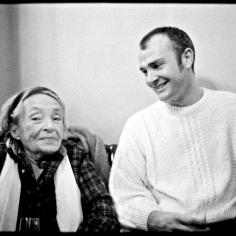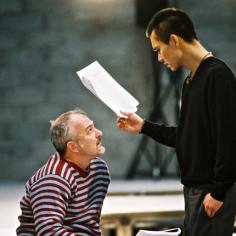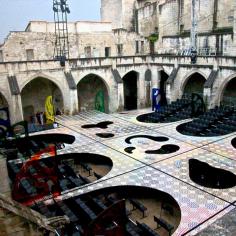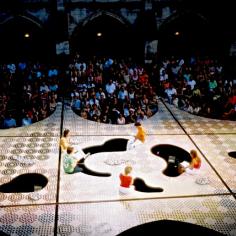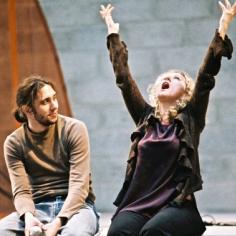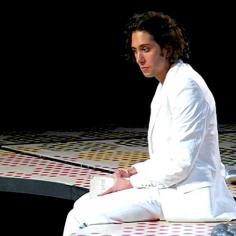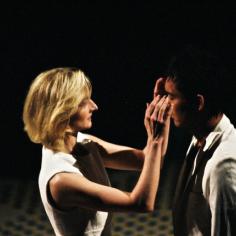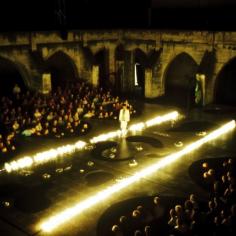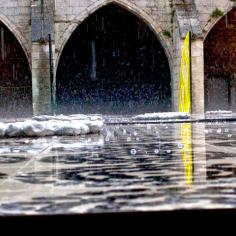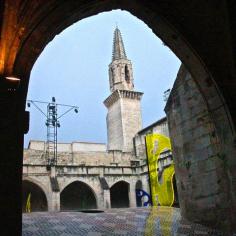2006 · Pluie d’été à Hiroshima · Duras · Vigner (EN)
"One might say that the text is the house. The house, that’s the book, it is what is written. And it is in that house that I develop my mise-en-scène, word for word, step by step." [1]
In 1993, MARGUERITE DURAS came to see LA PLUIE D’ÉTÉ, put on stage by ERIC VIGNER. She loved the work and offered him the scenario of HIROSHIMA MON AMOUR.
In 1996 occured the death of Marguerite Duras, ten years ago, ten years during which VIGNER kept exploring her works (reading of HIROSHIMA MON AMOUR with Valérie Dréville, LA DOULEUR with ANNE BROCHET and BÉNÉDICTE VIGNER, LA BÊTE DANS LA JUNGLE with JEAN-DAMIEN BARBINE and JUTTA JOHANNA WEISS, SAVANNAH BAY, as the first DURAS play to be added to the repertory of the Comédie-Française, with CATHERINE HIEGEL and CATHERINE SAMIE). On the occasion of the ten-year celebration of the CDDB - Théâtre de Lorient, VIGNER reverts to the present he had received at the hands of MARGUERITE DURAS: the scenario of HIROSHIMA MON AMOUR. He reassociates the scenario to the text that had been seminal to his early work, LA PLUIE D’ÉTÉ and thus presents PLUIE D’ÉTÉ À HIROSHIMA for the 60th anniversary of the Avignon Festival, with HÉLÈNE BABU, BÉNÉDICTE CERUTTI, THIERRY GODARD, NICOLAS MARCHAND, MARIE-ÉLÉONORE POURTOIS, THOMAS SCIMECA, ATSURO WATABE and JUTTA JOHANNA WEISS.
THE CARMELITE CLOISTER FOR MARGUERITE
Since 1967 the cloister adjoining the fourteenth-century Carmelite Church has been used for performances of the Avignon Festival - always in the traditional way, with the public facing the stage. When looking for possible locations, Vigner was intrigued by the cloister as an architectural space that invited meditation, by its ‘striving towards the heavens’. His arrangement, then, for this year’s festival constitutes a first: "I wanted to place the audience in the architecture, the body of the writing. When you put people just in front of whatever takes place on the stage, you most of the time confront them with ideas.
In his PLUIE D’ÉTÉ À HIROSHIMA, VIGNER invites his audience to join him on a voyage through MARGUERITE DURAS’ œuvre - through two works, in particular, that count among the writer’s finest pages. Love, death, desire, memory and oblivion are the themes that traverse, from one tale to the other, one and the same writing.
"If I decided some time ago to devote myself to what is commonly called mise-en-scène, I did so because I wanted to try to physically involve the public in the process, so that they would become sensitive to what the creative process of writing generates. I do theatre on the basis of the imaginative force of text, a process which is close to poetry."
ÉRIC VIGNER
What MARGUERITE DURAS has left us also is her capacity to revert again and again to, and to rework, her own œuvre and to leave her works to posterity as just one option among many others. Her writings have taken the form of books, novels, theatre plays, film scenarios, films… She is no longer, but her works pursue their course and engender new ones. This is also the reason why VIGNER involves the graphic artists M/M in this endeavour: they, too, constantly rework their own graphic œuvre as something to be renewed and recirculated. With them, VIGNER gives rise to a new form of art in which three textual levels communicate with each other - the writing, its staging, and its continuous visual unfolding.
"MARGUERITE DURAS’ œuvre constitutes one whole. A whole made up of different periods that may be more or less abstract, droll, concrete, tragic. But each of them is linked with and refers to all the others and vice versa. The heroes of her stories respond from one book to another. The task of the actors and of the director is to deeply rely on the writing, in order to attain and transmit to the audience feelings on which the text is based. The theatre has always to do with the question of how to give presence to a text, and the works of Duras make this question all the more evident and inescapable."
ÉV
"At that point in his life Ernesto was supposed not to be able to read, but he said he’d read some of the burned book. Just like that, he said, without thinking about it, without even knowing what he was doing. And then - well, then he stopped bothering whether he was really reading or not, or even what reading was - whether it was this or something else. At first, he said, he’d tried like this: he took the shape of a word and quite arbitrarily gave it a provisional meaning. Then he gave the next word another meaning, but in terms of the assumed provisional meaning of the first word. And he went on like that until the whole sentence yielded some sense. In this way he came to see that reading was a kind of continuous unfolding within his own body of a story invented by himself." [2]
"At the end of LA PLUIE D’ÉTÉ, Ernesto, the child who discovers Ecclesiastes even though he has never learnt to read, ‘becomes a brilliant young professor of mathematics and than a scientist. First he was offered a job in America, then others all over the world, wherever there was a big scientific center.’ The family breaks apart, and from its ruins, right from the flames kindled in the ruins of LA PLUIE D’ÉTÉ, ultimately rises the magnificent woman who hears a voice tell her ‘You saw nothing in Hiroshima. Nothing."
ÉV
"And I saw another mighty angel come down from heaven, clothed with a cloud; and a rainbow was upon his head, and his face was as it were the sun, and his feet as pillars of fire; and he had in his hand a little book open: and he set his right foot upon the sea, and his left foot on the earth, and cried with a loud voice, as when a lion roareth; and when he had cried, seven thunders uttered their voices. And when the seven thunders had uttered their voices, I was about to write: and I heard a voice from heaven saying unto me, seal up those things which the seven thunders uttered, and write them not. And the angel which I saw stand upon the sea and upon the earth lifted up his hand to heaven, and sware by him that liveth for ever and ever, who created heaven, and the things that therein are, and the earth, and the things that therein are, and the sea, and the things which are therein, that there should be time no longer.” [3]
"Living means, on an individual level, to connect present and past - but also that present and past form a whole, because they touch each other in one point. And what is the present if not exactly that touching?" [4]
"Time will pass. Nothing but time.
And time will come.
Time is coming. When we shall not know how to name what will unite us.
The name will vanish little by little from our memory.
Then, it will disappear completely." [5]
Après le Festival d’Avignon, Pluie d’ÉTÉ À Hiroshima tourne en France en 2006/07, notamment au Théâtre des Amandiers à Nanterre, au Quartz à Brest et au TNT à Toulouse.
© Photography : Alain Fonteray
Texts assembled by Jutta Johanna Weiss
Translation from the French by Herbert Kaiser
© CDDB-Théâtre de Lorient
